Financial Accounting Assignment Solution with Analysis
VerifiedAdded on 2023/01/10
|16
|3183
|74
Homework Assignment
AI Summary
This assignment solution addresses a financial accounting problem, beginning with the preparation of a trading account, profit and loss account, and balance sheet for a fabric shop proprietor. It then critically evaluates the features of financial information, emphasizing its importance to users and stakeholders. The solution includes a detailed ratio analysis, calculating and interpreting various ratios such as gross profit margin, return on capital employed, current ratio, trade payable days, and debtor collection period. Furthermore, the assignment demonstrates the creation of journal entries, ledger accounts, and a trial balance to record financial transactions. Finally, the solution explains the significance of different accounting concepts, such as the straight-line method for depreciation, providing a comprehensive overview of the financial accounting principles involved.
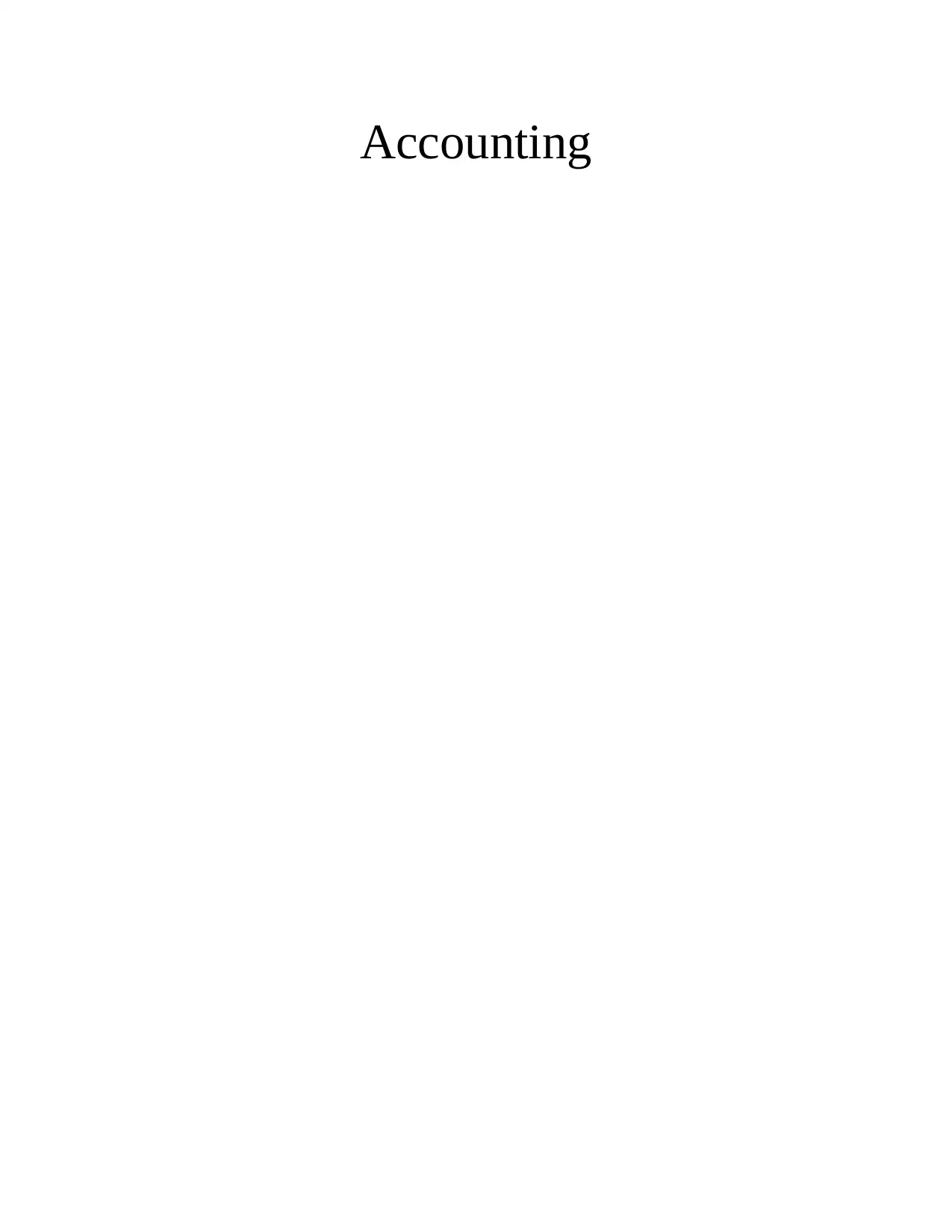
Accounting
Paraphrase This Document
Need a fresh take? Get an instant paraphrase of this document with our AI Paraphraser
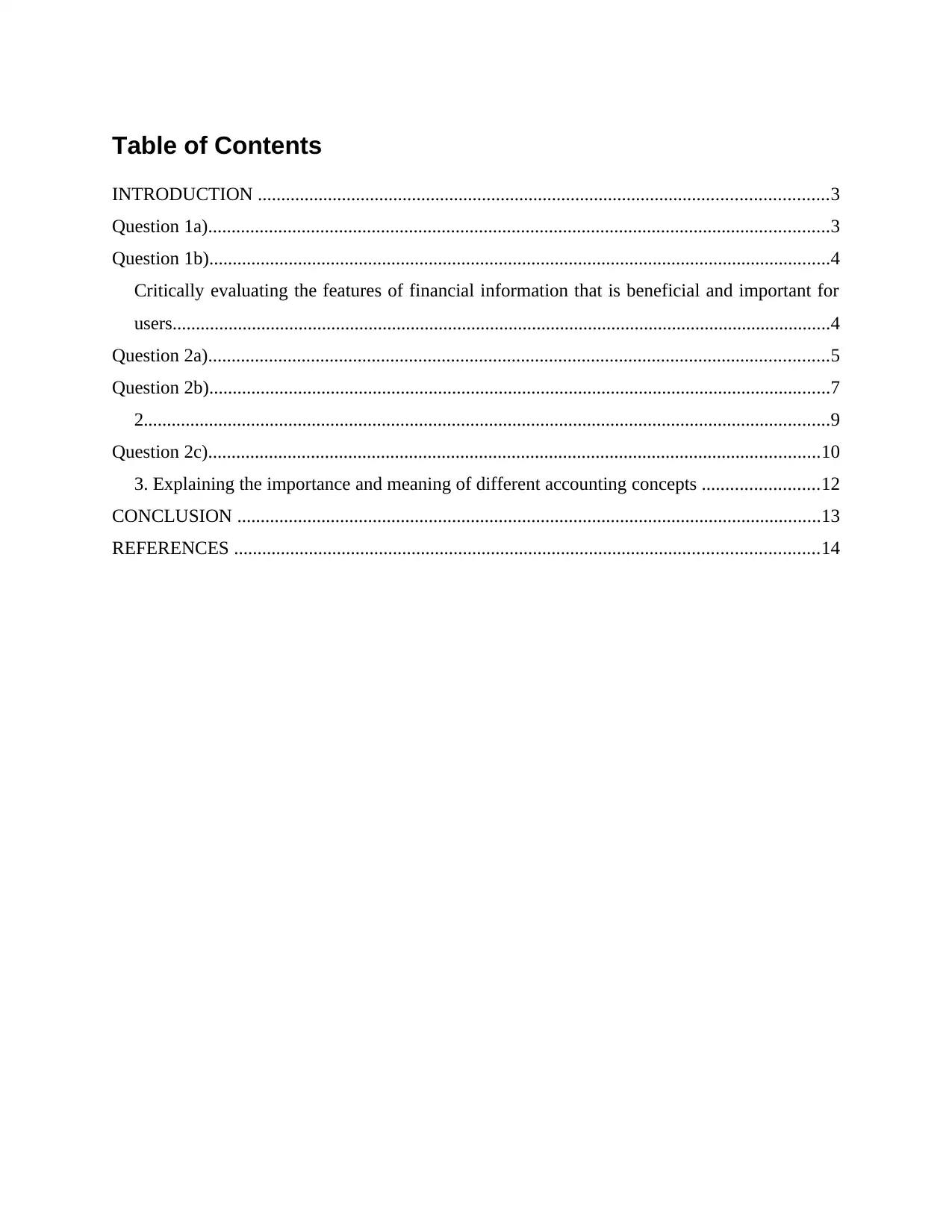
Table of Contents
INTRODUCTION ..........................................................................................................................3
Question 1a).....................................................................................................................................3
Question 1b).....................................................................................................................................4
Critically evaluating the features of financial information that is beneficial and important for
users.............................................................................................................................................4
Question 2a).....................................................................................................................................5
Question 2b).....................................................................................................................................7
2...................................................................................................................................................9
Question 2c)...................................................................................................................................10
3. Explaining the importance and meaning of different accounting concepts .........................12
CONCLUSION .............................................................................................................................13
REFERENCES .............................................................................................................................14
INTRODUCTION ..........................................................................................................................3
Question 1a).....................................................................................................................................3
Question 1b).....................................................................................................................................4
Critically evaluating the features of financial information that is beneficial and important for
users.............................................................................................................................................4
Question 2a).....................................................................................................................................5
Question 2b).....................................................................................................................................7
2...................................................................................................................................................9
Question 2c)...................................................................................................................................10
3. Explaining the importance and meaning of different accounting concepts .........................12
CONCLUSION .............................................................................................................................13
REFERENCES .............................................................................................................................14
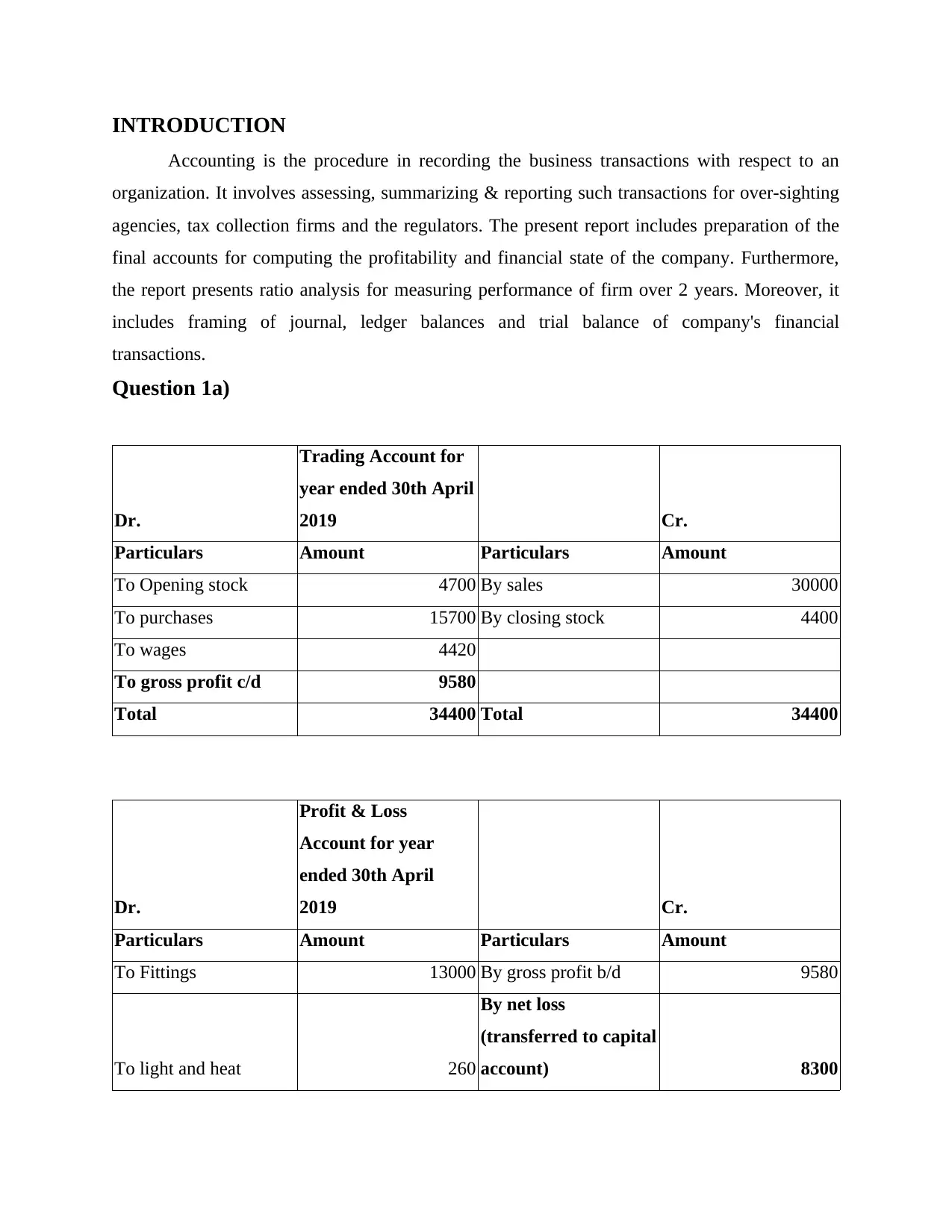
INTRODUCTION
Accounting is the procedure in recording the business transactions with respect to an
organization. It involves assessing, summarizing & reporting such transactions for over-sighting
agencies, tax collection firms and the regulators. The present report includes preparation of the
final accounts for computing the profitability and financial state of the company. Furthermore,
the report presents ratio analysis for measuring performance of firm over 2 years. Moreover, it
includes framing of journal, ledger balances and trial balance of company's financial
transactions.
Question 1a)
Dr.
Trading Account for
year ended 30th April
2019 Cr.
Particulars Amount Particulars Amount
To Opening stock 4700 By sales 30000
To purchases 15700 By closing stock 4400
To wages 4420
To gross profit c/d 9580
Total 34400 Total 34400
Dr.
Profit & Loss
Account for year
ended 30th April
2019 Cr.
Particulars Amount Particulars Amount
To Fittings 13000 By gross profit b/d 9580
To light and heat 260
By net loss
(transferred to capital
account) 8300
Accounting is the procedure in recording the business transactions with respect to an
organization. It involves assessing, summarizing & reporting such transactions for over-sighting
agencies, tax collection firms and the regulators. The present report includes preparation of the
final accounts for computing the profitability and financial state of the company. Furthermore,
the report presents ratio analysis for measuring performance of firm over 2 years. Moreover, it
includes framing of journal, ledger balances and trial balance of company's financial
transactions.
Question 1a)
Dr.
Trading Account for
year ended 30th April
2019 Cr.
Particulars Amount Particulars Amount
To Opening stock 4700 By sales 30000
To purchases 15700 By closing stock 4400
To wages 4420
To gross profit c/d 9580
Total 34400 Total 34400
Dr.
Profit & Loss
Account for year
ended 30th April
2019 Cr.
Particulars Amount Particulars Amount
To Fittings 13000 By gross profit b/d 9580
To light and heat 260
By net loss
(transferred to capital
account) 8300
⊘ This is a preview!⊘
Do you want full access?
Subscribe today to unlock all pages.

Trusted by 1+ million students worldwide
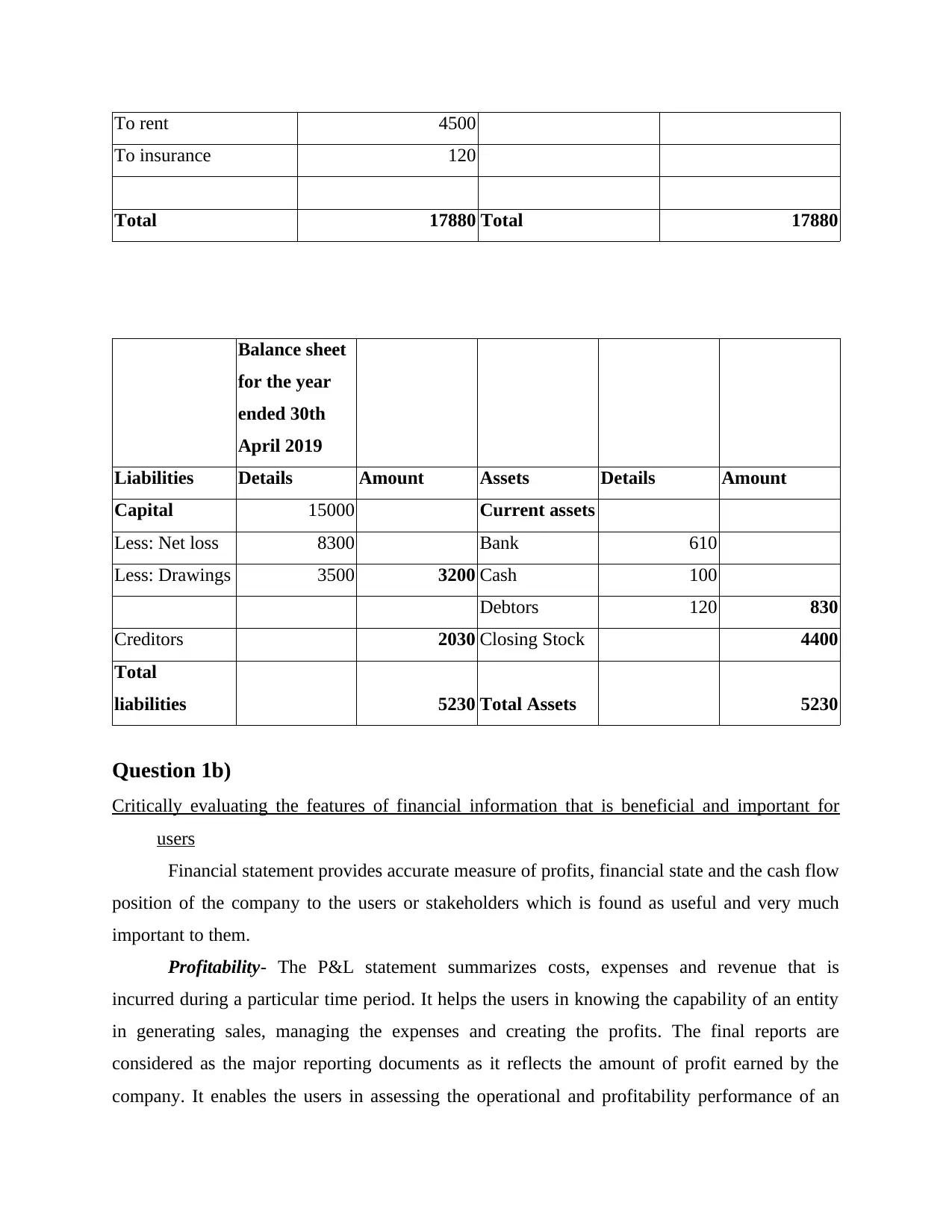
To rent 4500
To insurance 120
Total 17880 Total 17880
Balance sheet
for the year
ended 30th
April 2019
Liabilities Details Amount Assets Details Amount
Capital 15000 Current assets
Less: Net loss 8300 Bank 610
Less: Drawings 3500 3200 Cash 100
Debtors 120 830
Creditors 2030 Closing Stock 4400
Total
liabilities 5230 Total Assets 5230
Question 1b)
Critically evaluating the features of financial information that is beneficial and important for
users
Financial statement provides accurate measure of profits, financial state and the cash flow
position of the company to the users or stakeholders which is found as useful and very much
important to them.
Profitability- The P&L statement summarizes costs, expenses and revenue that is
incurred during a particular time period. It helps the users in knowing the capability of an entity
in generating sales, managing the expenses and creating the profits. The final reports are
considered as the major reporting documents as it reflects the amount of profit earned by the
company. It enables the users in assessing the operational and profitability performance of an
To insurance 120
Total 17880 Total 17880
Balance sheet
for the year
ended 30th
April 2019
Liabilities Details Amount Assets Details Amount
Capital 15000 Current assets
Less: Net loss 8300 Bank 610
Less: Drawings 3500 3200 Cash 100
Debtors 120 830
Creditors 2030 Closing Stock 4400
Total
liabilities 5230 Total Assets 5230
Question 1b)
Critically evaluating the features of financial information that is beneficial and important for
users
Financial statement provides accurate measure of profits, financial state and the cash flow
position of the company to the users or stakeholders which is found as useful and very much
important to them.
Profitability- The P&L statement summarizes costs, expenses and revenue that is
incurred during a particular time period. It helps the users in knowing the capability of an entity
in generating sales, managing the expenses and creating the profits. The final reports are
considered as the major reporting documents as it reflects the amount of profit earned by the
company. It enables the users in assessing the operational and profitability performance of an
Paraphrase This Document
Need a fresh take? Get an instant paraphrase of this document with our AI Paraphraser
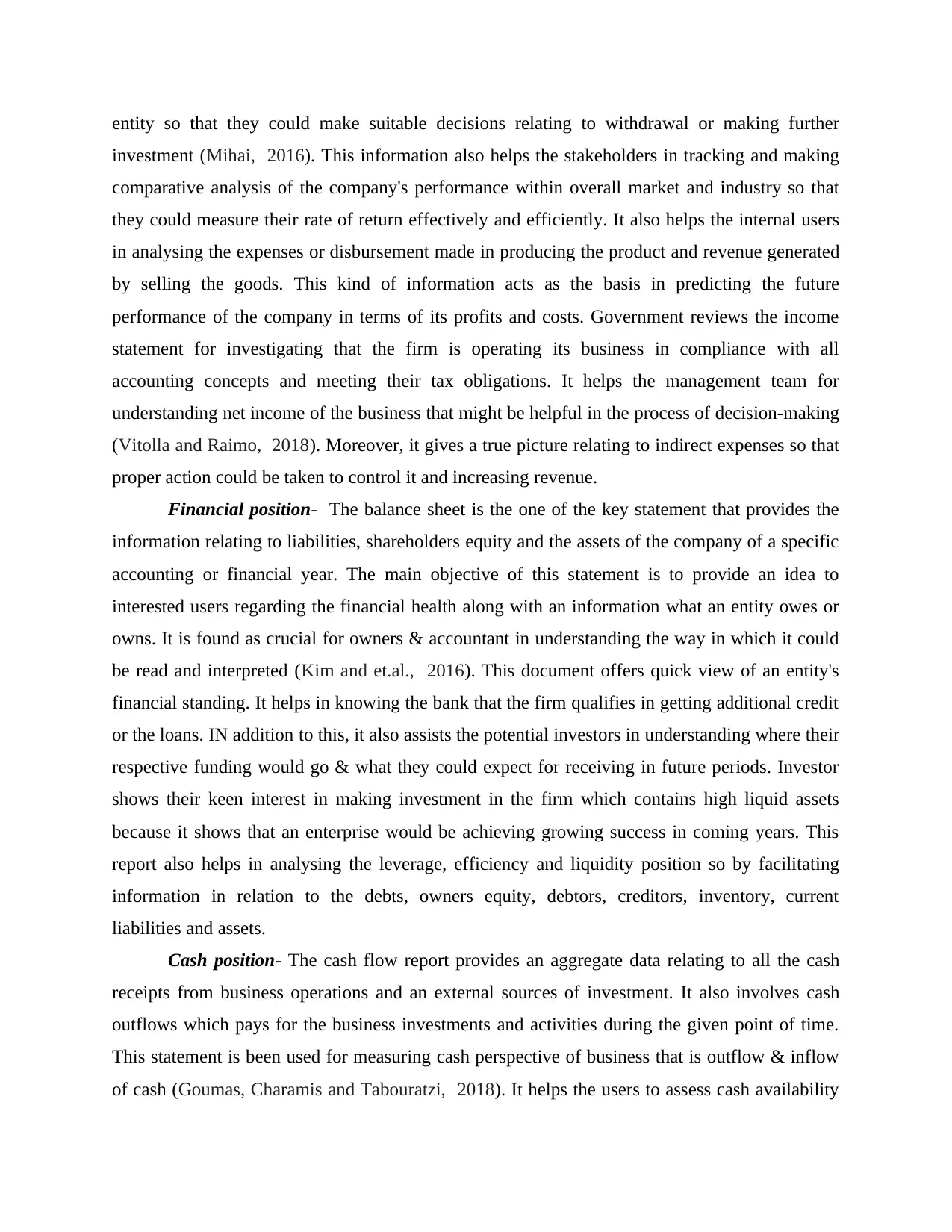
entity so that they could make suitable decisions relating to withdrawal or making further
investment (Mihai, 2016). This information also helps the stakeholders in tracking and making
comparative analysis of the company's performance within overall market and industry so that
they could measure their rate of return effectively and efficiently. It also helps the internal users
in analysing the expenses or disbursement made in producing the product and revenue generated
by selling the goods. This kind of information acts as the basis in predicting the future
performance of the company in terms of its profits and costs. Government reviews the income
statement for investigating that the firm is operating its business in compliance with all
accounting concepts and meeting their tax obligations. It helps the management team for
understanding net income of the business that might be helpful in the process of decision-making
(Vitolla and Raimo, 2018). Moreover, it gives a true picture relating to indirect expenses so that
proper action could be taken to control it and increasing revenue.
Financial position- The balance sheet is the one of the key statement that provides the
information relating to liabilities, shareholders equity and the assets of the company of a specific
accounting or financial year. The main objective of this statement is to provide an idea to
interested users regarding the financial health along with an information what an entity owes or
owns. It is found as crucial for owners & accountant in understanding the way in which it could
be read and interpreted (Kim and et.al., 2016). This document offers quick view of an entity's
financial standing. It helps in knowing the bank that the firm qualifies in getting additional credit
or the loans. IN addition to this, it also assists the potential investors in understanding where their
respective funding would go & what they could expect for receiving in future periods. Investor
shows their keen interest in making investment in the firm which contains high liquid assets
because it shows that an enterprise would be achieving growing success in coming years. This
report also helps in analysing the leverage, efficiency and liquidity position so by facilitating
information in relation to the debts, owners equity, debtors, creditors, inventory, current
liabilities and assets.
Cash position- The cash flow report provides an aggregate data relating to all the cash
receipts from business operations and an external sources of investment. It also involves cash
outflows which pays for the business investments and activities during the given point of time.
This statement is been used for measuring cash perspective of business that is outflow & inflow
of cash (Goumas, Charamis and Tabouratzi, 2018). It helps the users to assess cash availability
investment (Mihai, 2016). This information also helps the stakeholders in tracking and making
comparative analysis of the company's performance within overall market and industry so that
they could measure their rate of return effectively and efficiently. It also helps the internal users
in analysing the expenses or disbursement made in producing the product and revenue generated
by selling the goods. This kind of information acts as the basis in predicting the future
performance of the company in terms of its profits and costs. Government reviews the income
statement for investigating that the firm is operating its business in compliance with all
accounting concepts and meeting their tax obligations. It helps the management team for
understanding net income of the business that might be helpful in the process of decision-making
(Vitolla and Raimo, 2018). Moreover, it gives a true picture relating to indirect expenses so that
proper action could be taken to control it and increasing revenue.
Financial position- The balance sheet is the one of the key statement that provides the
information relating to liabilities, shareholders equity and the assets of the company of a specific
accounting or financial year. The main objective of this statement is to provide an idea to
interested users regarding the financial health along with an information what an entity owes or
owns. It is found as crucial for owners & accountant in understanding the way in which it could
be read and interpreted (Kim and et.al., 2016). This document offers quick view of an entity's
financial standing. It helps in knowing the bank that the firm qualifies in getting additional credit
or the loans. IN addition to this, it also assists the potential investors in understanding where their
respective funding would go & what they could expect for receiving in future periods. Investor
shows their keen interest in making investment in the firm which contains high liquid assets
because it shows that an enterprise would be achieving growing success in coming years. This
report also helps in analysing the leverage, efficiency and liquidity position so by facilitating
information in relation to the debts, owners equity, debtors, creditors, inventory, current
liabilities and assets.
Cash position- The cash flow report provides an aggregate data relating to all the cash
receipts from business operations and an external sources of investment. It also involves cash
outflows which pays for the business investments and activities during the given point of time.
This statement is been used for measuring cash perspective of business that is outflow & inflow
of cash (Goumas, Charamis and Tabouratzi, 2018). It helps the users to assess cash availability
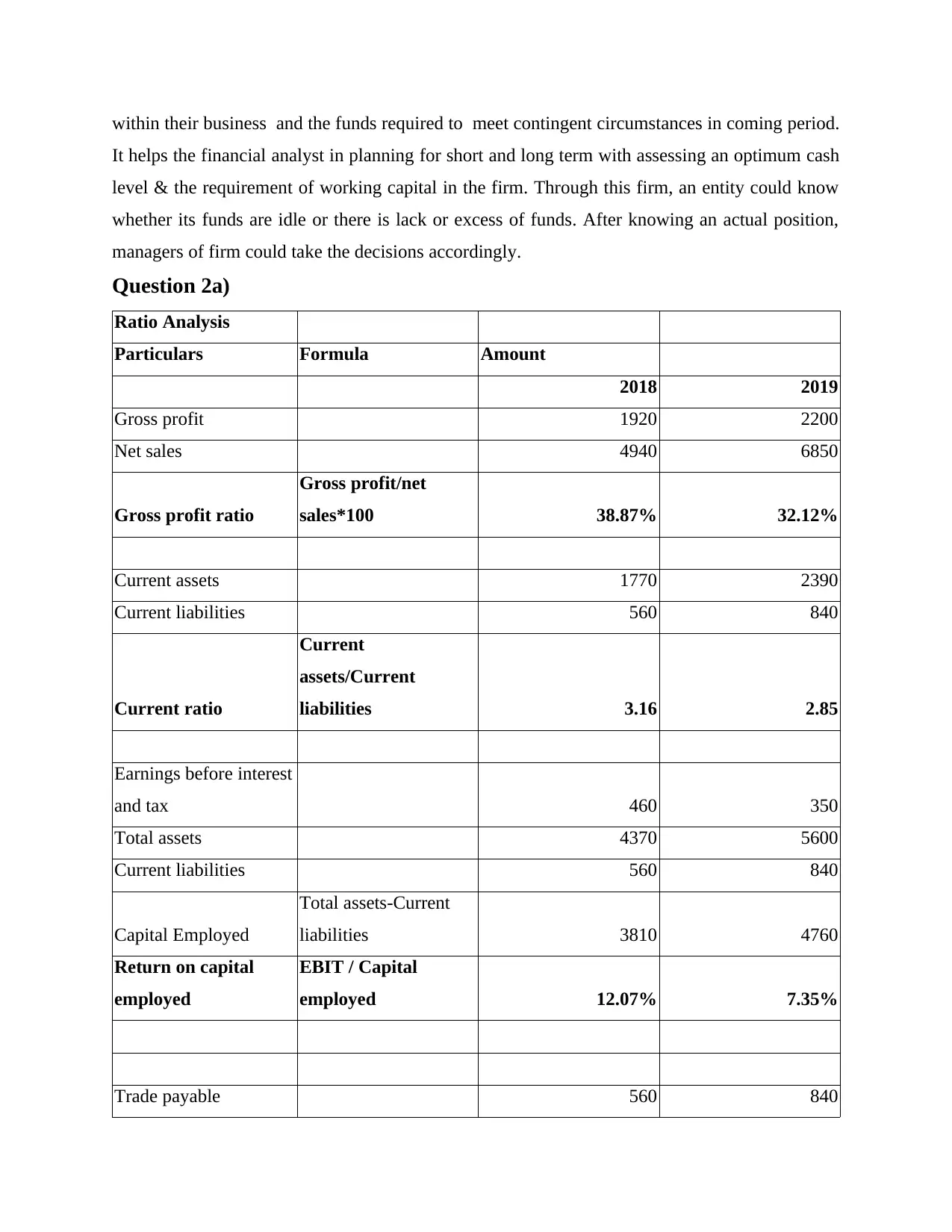
within their business and the funds required to meet contingent circumstances in coming period.
It helps the financial analyst in planning for short and long term with assessing an optimum cash
level & the requirement of working capital in the firm. Through this firm, an entity could know
whether its funds are idle or there is lack or excess of funds. After knowing an actual position,
managers of firm could take the decisions accordingly.
Question 2a)
Ratio Analysis
Particulars Formula Amount
2018 2019
Gross profit 1920 2200
Net sales 4940 6850
Gross profit ratio
Gross profit/net
sales*100 38.87% 32.12%
Current assets 1770 2390
Current liabilities 560 840
Current ratio
Current
assets/Current
liabilities 3.16 2.85
Earnings before interest
and tax 460 350
Total assets 4370 5600
Current liabilities 560 840
Capital Employed
Total assets-Current
liabilities 3810 4760
Return on capital
employed
EBIT / Capital
employed 12.07% 7.35%
Trade payable 560 840
It helps the financial analyst in planning for short and long term with assessing an optimum cash
level & the requirement of working capital in the firm. Through this firm, an entity could know
whether its funds are idle or there is lack or excess of funds. After knowing an actual position,
managers of firm could take the decisions accordingly.
Question 2a)
Ratio Analysis
Particulars Formula Amount
2018 2019
Gross profit 1920 2200
Net sales 4940 6850
Gross profit ratio
Gross profit/net
sales*100 38.87% 32.12%
Current assets 1770 2390
Current liabilities 560 840
Current ratio
Current
assets/Current
liabilities 3.16 2.85
Earnings before interest
and tax 460 350
Total assets 4370 5600
Current liabilities 560 840
Capital Employed
Total assets-Current
liabilities 3810 4760
Return on capital
employed
EBIT / Capital
employed 12.07% 7.35%
Trade payable 560 840
⊘ This is a preview!⊘
Do you want full access?
Subscribe today to unlock all pages.

Trusted by 1+ million students worldwide
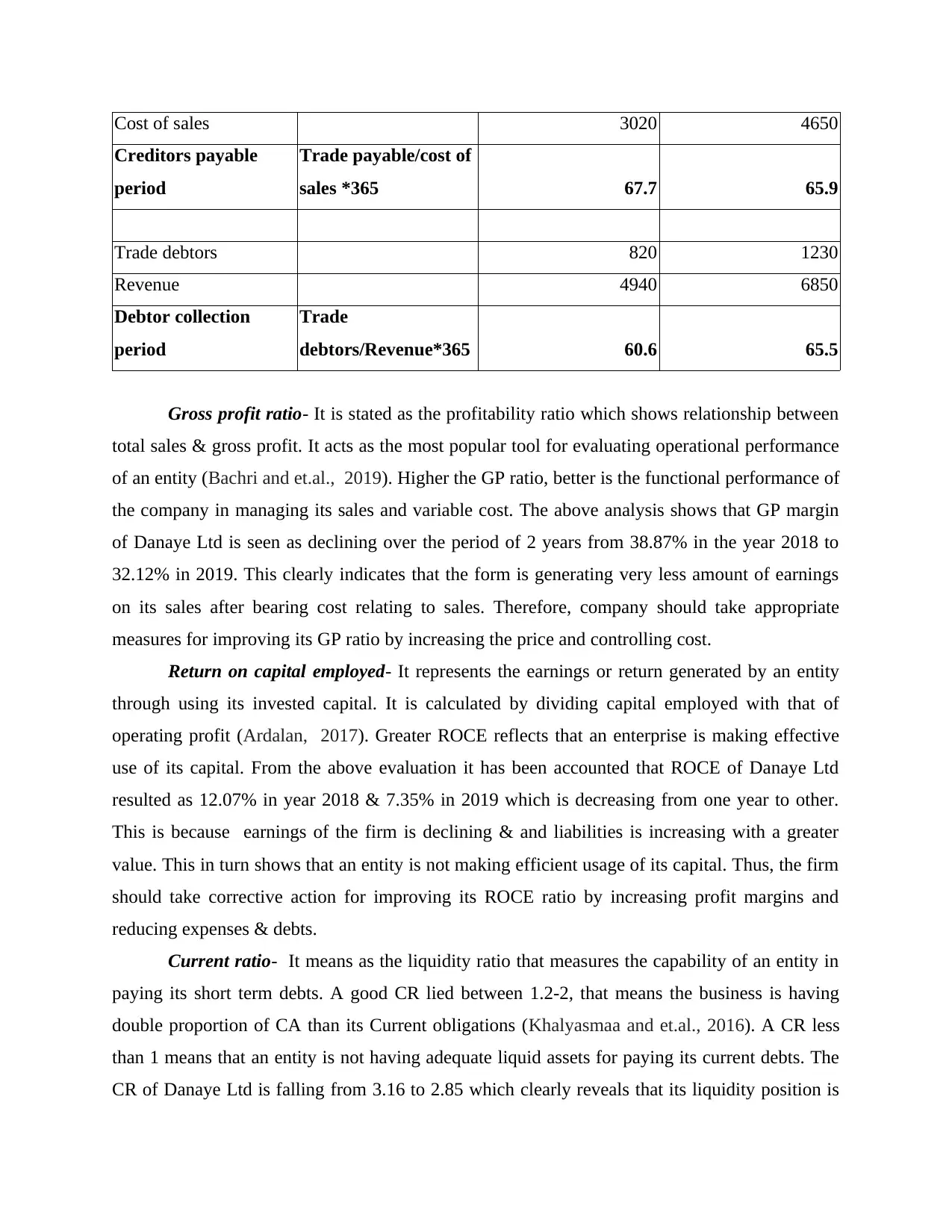
Cost of sales 3020 4650
Creditors payable
period
Trade payable/cost of
sales *365 67.7 65.9
Trade debtors 820 1230
Revenue 4940 6850
Debtor collection
period
Trade
debtors/Revenue*365 60.6 65.5
Gross profit ratio- It is stated as the profitability ratio which shows relationship between
total sales & gross profit. It acts as the most popular tool for evaluating operational performance
of an entity (Bachri and et.al., 2019). Higher the GP ratio, better is the functional performance of
the company in managing its sales and variable cost. The above analysis shows that GP margin
of Danaye Ltd is seen as declining over the period of 2 years from 38.87% in the year 2018 to
32.12% in 2019. This clearly indicates that the form is generating very less amount of earnings
on its sales after bearing cost relating to sales. Therefore, company should take appropriate
measures for improving its GP ratio by increasing the price and controlling cost.
Return on capital employed- It represents the earnings or return generated by an entity
through using its invested capital. It is calculated by dividing capital employed with that of
operating profit (Ardalan, 2017). Greater ROCE reflects that an enterprise is making effective
use of its capital. From the above evaluation it has been accounted that ROCE of Danaye Ltd
resulted as 12.07% in year 2018 & 7.35% in 2019 which is decreasing from one year to other.
This is because earnings of the firm is declining & and liabilities is increasing with a greater
value. This in turn shows that an entity is not making efficient usage of its capital. Thus, the firm
should take corrective action for improving its ROCE ratio by increasing profit margins and
reducing expenses & debts.
Current ratio- It means as the liquidity ratio that measures the capability of an entity in
paying its short term debts. A good CR lied between 1.2-2, that means the business is having
double proportion of CA than its Current obligations (Khalyasmaa and et.al., 2016). A CR less
than 1 means that an entity is not having adequate liquid assets for paying its current debts. The
CR of Danaye Ltd is falling from 3.16 to 2.85 which clearly reveals that its liquidity position is
Creditors payable
period
Trade payable/cost of
sales *365 67.7 65.9
Trade debtors 820 1230
Revenue 4940 6850
Debtor collection
period
Trade
debtors/Revenue*365 60.6 65.5
Gross profit ratio- It is stated as the profitability ratio which shows relationship between
total sales & gross profit. It acts as the most popular tool for evaluating operational performance
of an entity (Bachri and et.al., 2019). Higher the GP ratio, better is the functional performance of
the company in managing its sales and variable cost. The above analysis shows that GP margin
of Danaye Ltd is seen as declining over the period of 2 years from 38.87% in the year 2018 to
32.12% in 2019. This clearly indicates that the form is generating very less amount of earnings
on its sales after bearing cost relating to sales. Therefore, company should take appropriate
measures for improving its GP ratio by increasing the price and controlling cost.
Return on capital employed- It represents the earnings or return generated by an entity
through using its invested capital. It is calculated by dividing capital employed with that of
operating profit (Ardalan, 2017). Greater ROCE reflects that an enterprise is making effective
use of its capital. From the above evaluation it has been accounted that ROCE of Danaye Ltd
resulted as 12.07% in year 2018 & 7.35% in 2019 which is decreasing from one year to other.
This is because earnings of the firm is declining & and liabilities is increasing with a greater
value. This in turn shows that an entity is not making efficient usage of its capital. Thus, the firm
should take corrective action for improving its ROCE ratio by increasing profit margins and
reducing expenses & debts.
Current ratio- It means as the liquidity ratio that measures the capability of an entity in
paying its short term debts. A good CR lied between 1.2-2, that means the business is having
double proportion of CA than its Current obligations (Khalyasmaa and et.al., 2016). A CR less
than 1 means that an entity is not having adequate liquid assets for paying its current debts. The
CR of Danaye Ltd is falling from 3.16 to 2.85 which clearly reveals that its liquidity position is
Paraphrase This Document
Need a fresh take? Get an instant paraphrase of this document with our AI Paraphraser
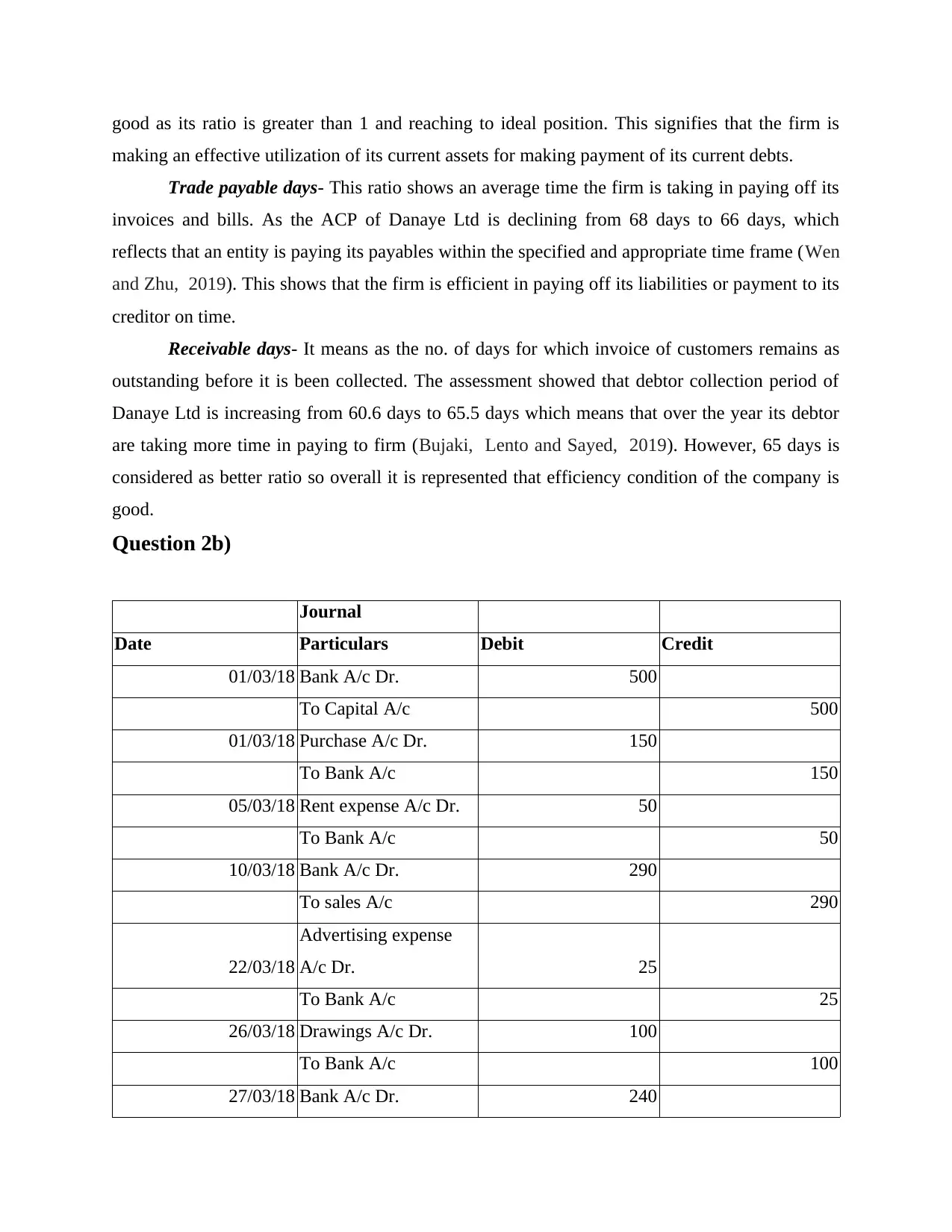
good as its ratio is greater than 1 and reaching to ideal position. This signifies that the firm is
making an effective utilization of its current assets for making payment of its current debts.
Trade payable days- This ratio shows an average time the firm is taking in paying off its
invoices and bills. As the ACP of Danaye Ltd is declining from 68 days to 66 days, which
reflects that an entity is paying its payables within the specified and appropriate time frame (Wen
and Zhu, 2019). This shows that the firm is efficient in paying off its liabilities or payment to its
creditor on time.
Receivable days- It means as the no. of days for which invoice of customers remains as
outstanding before it is been collected. The assessment showed that debtor collection period of
Danaye Ltd is increasing from 60.6 days to 65.5 days which means that over the year its debtor
are taking more time in paying to firm (Bujaki, Lento and Sayed, 2019). However, 65 days is
considered as better ratio so overall it is represented that efficiency condition of the company is
good.
Question 2b)
Journal
Date Particulars Debit Credit
01/03/18 Bank A/c Dr. 500
To Capital A/c 500
01/03/18 Purchase A/c Dr. 150
To Bank A/c 150
05/03/18 Rent expense A/c Dr. 50
To Bank A/c 50
10/03/18 Bank A/c Dr. 290
To sales A/c 290
22/03/18
Advertising expense
A/c Dr. 25
To Bank A/c 25
26/03/18 Drawings A/c Dr. 100
To Bank A/c 100
27/03/18 Bank A/c Dr. 240
making an effective utilization of its current assets for making payment of its current debts.
Trade payable days- This ratio shows an average time the firm is taking in paying off its
invoices and bills. As the ACP of Danaye Ltd is declining from 68 days to 66 days, which
reflects that an entity is paying its payables within the specified and appropriate time frame (Wen
and Zhu, 2019). This shows that the firm is efficient in paying off its liabilities or payment to its
creditor on time.
Receivable days- It means as the no. of days for which invoice of customers remains as
outstanding before it is been collected. The assessment showed that debtor collection period of
Danaye Ltd is increasing from 60.6 days to 65.5 days which means that over the year its debtor
are taking more time in paying to firm (Bujaki, Lento and Sayed, 2019). However, 65 days is
considered as better ratio so overall it is represented that efficiency condition of the company is
good.
Question 2b)
Journal
Date Particulars Debit Credit
01/03/18 Bank A/c Dr. 500
To Capital A/c 500
01/03/18 Purchase A/c Dr. 150
To Bank A/c 150
05/03/18 Rent expense A/c Dr. 50
To Bank A/c 50
10/03/18 Bank A/c Dr. 290
To sales A/c 290
22/03/18
Advertising expense
A/c Dr. 25
To Bank A/c 25
26/03/18 Drawings A/c Dr. 100
To Bank A/c 100
27/03/18 Bank A/c Dr. 240
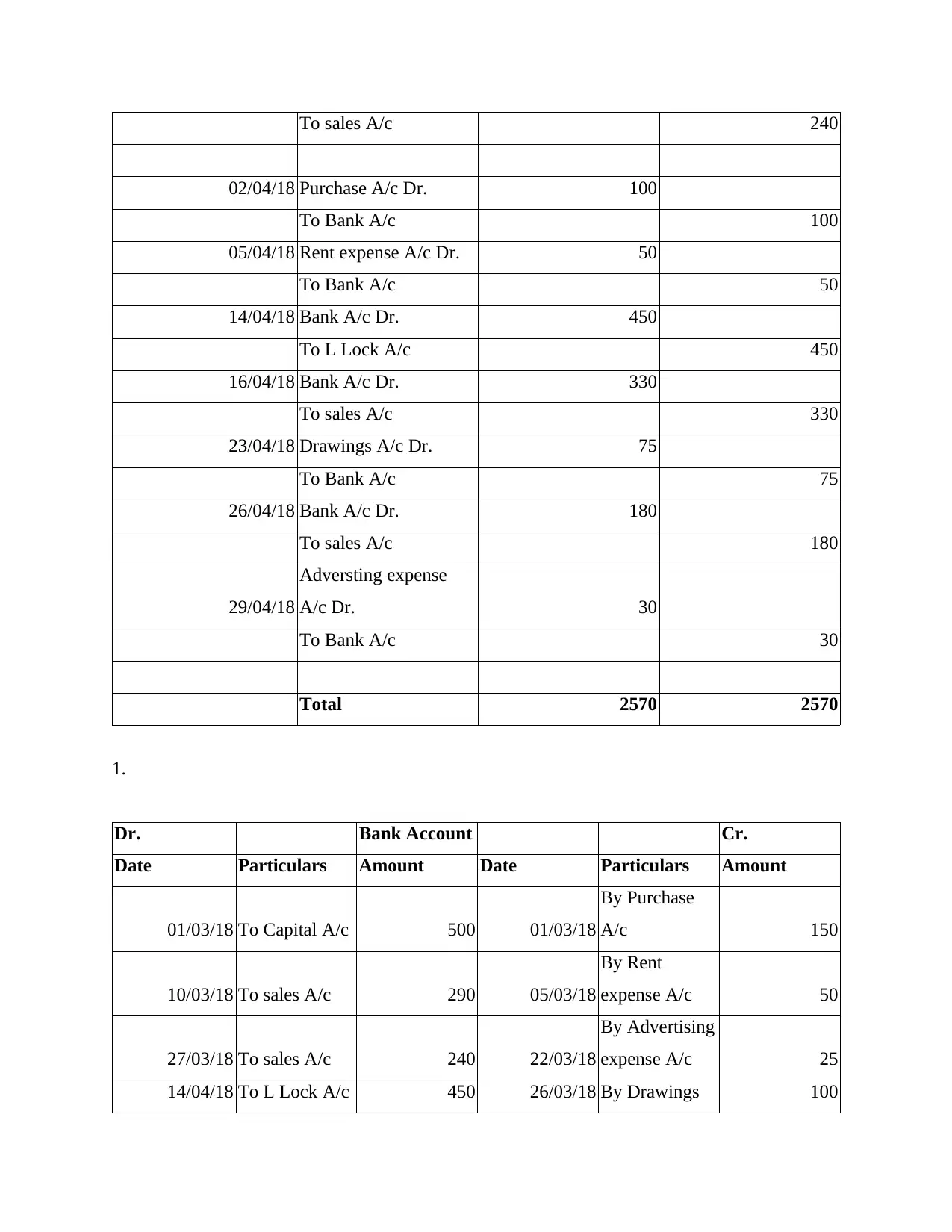
To sales A/c 240
02/04/18 Purchase A/c Dr. 100
To Bank A/c 100
05/04/18 Rent expense A/c Dr. 50
To Bank A/c 50
14/04/18 Bank A/c Dr. 450
To L Lock A/c 450
16/04/18 Bank A/c Dr. 330
To sales A/c 330
23/04/18 Drawings A/c Dr. 75
To Bank A/c 75
26/04/18 Bank A/c Dr. 180
To sales A/c 180
29/04/18
Adversting expense
A/c Dr. 30
To Bank A/c 30
Total 2570 2570
1.
Dr. Bank Account Cr.
Date Particulars Amount Date Particulars Amount
01/03/18 To Capital A/c 500 01/03/18
By Purchase
A/c 150
10/03/18 To sales A/c 290 05/03/18
By Rent
expense A/c 50
27/03/18 To sales A/c 240 22/03/18
By Advertising
expense A/c 25
14/04/18 To L Lock A/c 450 26/03/18 By Drawings 100
02/04/18 Purchase A/c Dr. 100
To Bank A/c 100
05/04/18 Rent expense A/c Dr. 50
To Bank A/c 50
14/04/18 Bank A/c Dr. 450
To L Lock A/c 450
16/04/18 Bank A/c Dr. 330
To sales A/c 330
23/04/18 Drawings A/c Dr. 75
To Bank A/c 75
26/04/18 Bank A/c Dr. 180
To sales A/c 180
29/04/18
Adversting expense
A/c Dr. 30
To Bank A/c 30
Total 2570 2570
1.
Dr. Bank Account Cr.
Date Particulars Amount Date Particulars Amount
01/03/18 To Capital A/c 500 01/03/18
By Purchase
A/c 150
10/03/18 To sales A/c 290 05/03/18
By Rent
expense A/c 50
27/03/18 To sales A/c 240 22/03/18
By Advertising
expense A/c 25
14/04/18 To L Lock A/c 450 26/03/18 By Drawings 100
⊘ This is a preview!⊘
Do you want full access?
Subscribe today to unlock all pages.

Trusted by 1+ million students worldwide
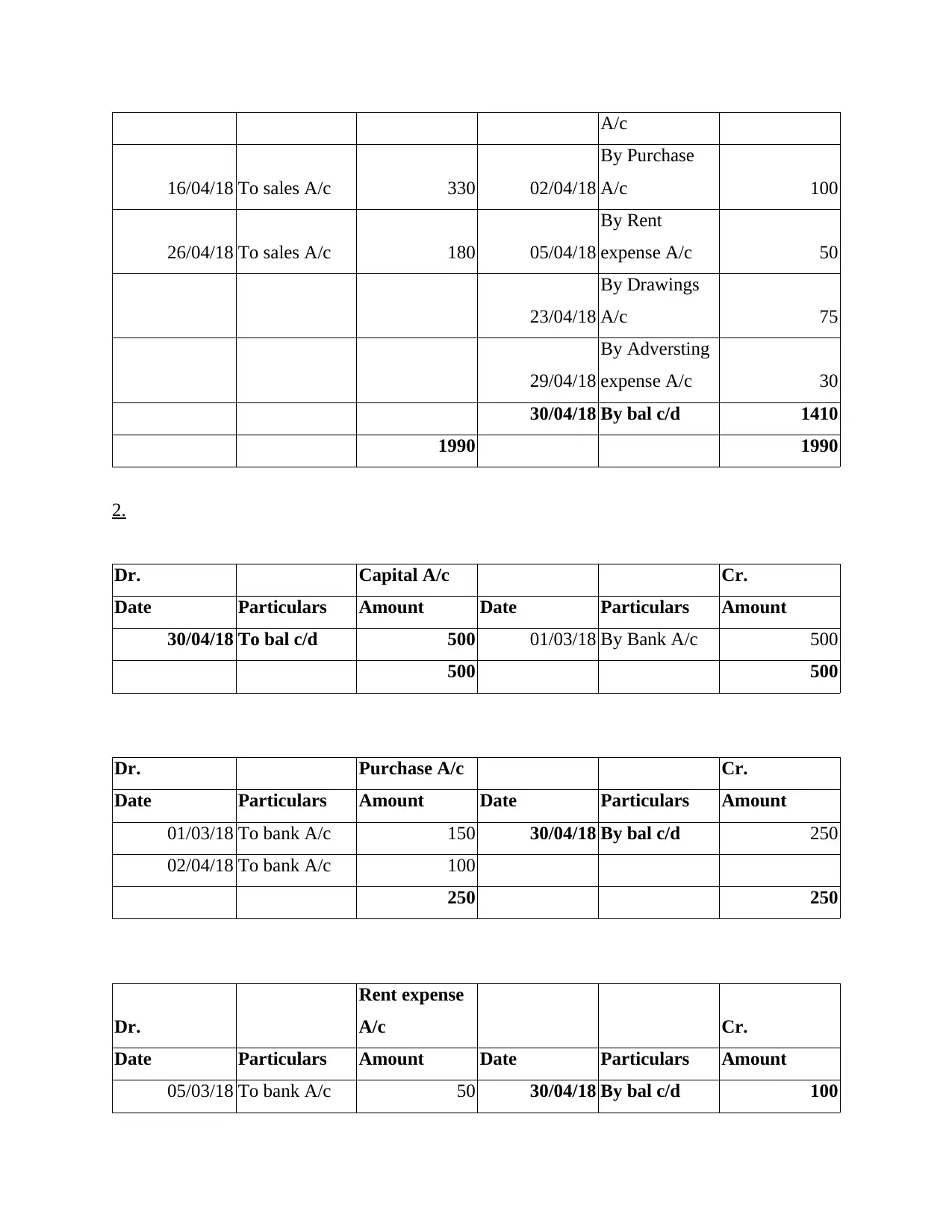
A/c
16/04/18 To sales A/c 330 02/04/18
By Purchase
A/c 100
26/04/18 To sales A/c 180 05/04/18
By Rent
expense A/c 50
23/04/18
By Drawings
A/c 75
29/04/18
By Adversting
expense A/c 30
30/04/18 By bal c/d 1410
1990 1990
2.
Dr. Capital A/c Cr.
Date Particulars Amount Date Particulars Amount
30/04/18 To bal c/d 500 01/03/18 By Bank A/c 500
500 500
Dr. Purchase A/c Cr.
Date Particulars Amount Date Particulars Amount
01/03/18 To bank A/c 150 30/04/18 By bal c/d 250
02/04/18 To bank A/c 100
250 250
Dr.
Rent expense
A/c Cr.
Date Particulars Amount Date Particulars Amount
05/03/18 To bank A/c 50 30/04/18 By bal c/d 100
16/04/18 To sales A/c 330 02/04/18
By Purchase
A/c 100
26/04/18 To sales A/c 180 05/04/18
By Rent
expense A/c 50
23/04/18
By Drawings
A/c 75
29/04/18
By Adversting
expense A/c 30
30/04/18 By bal c/d 1410
1990 1990
2.
Dr. Capital A/c Cr.
Date Particulars Amount Date Particulars Amount
30/04/18 To bal c/d 500 01/03/18 By Bank A/c 500
500 500
Dr. Purchase A/c Cr.
Date Particulars Amount Date Particulars Amount
01/03/18 To bank A/c 150 30/04/18 By bal c/d 250
02/04/18 To bank A/c 100
250 250
Dr.
Rent expense
A/c Cr.
Date Particulars Amount Date Particulars Amount
05/03/18 To bank A/c 50 30/04/18 By bal c/d 100
Paraphrase This Document
Need a fresh take? Get an instant paraphrase of this document with our AI Paraphraser
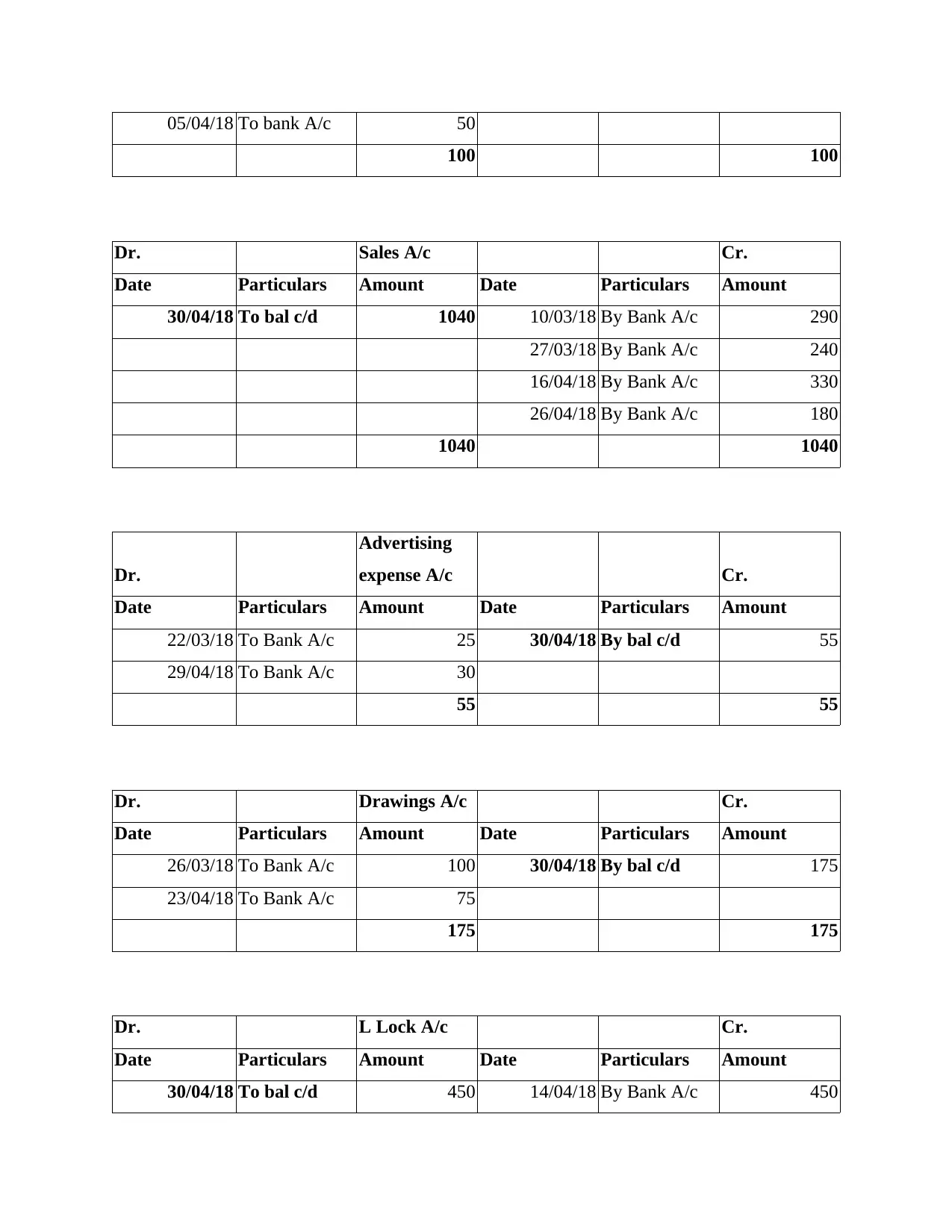
05/04/18 To bank A/c 50
100 100
Dr. Sales A/c Cr.
Date Particulars Amount Date Particulars Amount
30/04/18 To bal c/d 1040 10/03/18 By Bank A/c 290
27/03/18 By Bank A/c 240
16/04/18 By Bank A/c 330
26/04/18 By Bank A/c 180
1040 1040
Dr.
Advertising
expense A/c Cr.
Date Particulars Amount Date Particulars Amount
22/03/18 To Bank A/c 25 30/04/18 By bal c/d 55
29/04/18 To Bank A/c 30
55 55
Dr. Drawings A/c Cr.
Date Particulars Amount Date Particulars Amount
26/03/18 To Bank A/c 100 30/04/18 By bal c/d 175
23/04/18 To Bank A/c 75
175 175
Dr. L Lock A/c Cr.
Date Particulars Amount Date Particulars Amount
30/04/18 To bal c/d 450 14/04/18 By Bank A/c 450
100 100
Dr. Sales A/c Cr.
Date Particulars Amount Date Particulars Amount
30/04/18 To bal c/d 1040 10/03/18 By Bank A/c 290
27/03/18 By Bank A/c 240
16/04/18 By Bank A/c 330
26/04/18 By Bank A/c 180
1040 1040
Dr.
Advertising
expense A/c Cr.
Date Particulars Amount Date Particulars Amount
22/03/18 To Bank A/c 25 30/04/18 By bal c/d 55
29/04/18 To Bank A/c 30
55 55
Dr. Drawings A/c Cr.
Date Particulars Amount Date Particulars Amount
26/03/18 To Bank A/c 100 30/04/18 By bal c/d 175
23/04/18 To Bank A/c 75
175 175
Dr. L Lock A/c Cr.
Date Particulars Amount Date Particulars Amount
30/04/18 To bal c/d 450 14/04/18 By Bank A/c 450
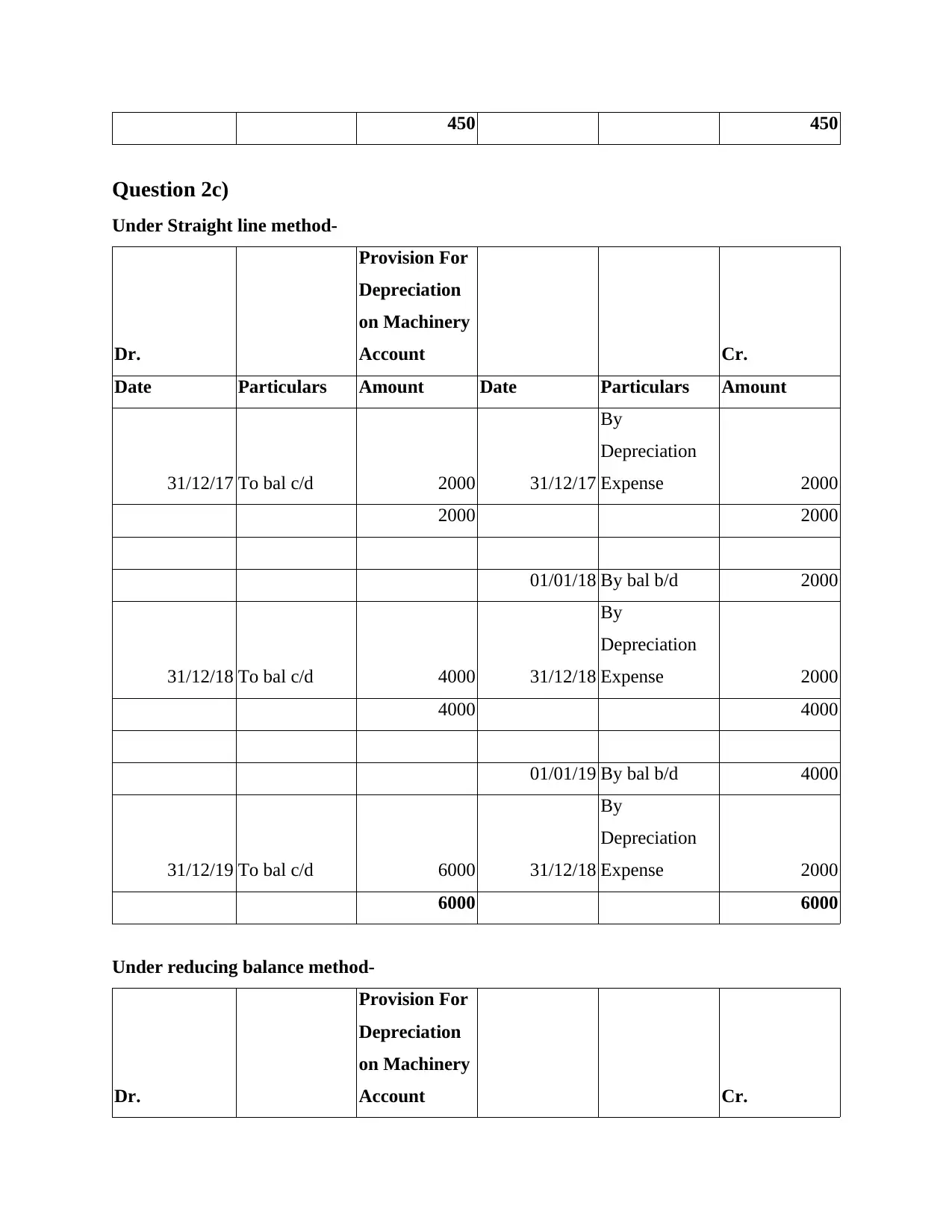
450 450
Question 2c)
Under Straight line method-
Dr.
Provision For
Depreciation
on Machinery
Account Cr.
Date Particulars Amount Date Particulars Amount
31/12/17 To bal c/d 2000 31/12/17
By
Depreciation
Expense 2000
2000 2000
01/01/18 By bal b/d 2000
31/12/18 To bal c/d 4000 31/12/18
By
Depreciation
Expense 2000
4000 4000
01/01/19 By bal b/d 4000
31/12/19 To bal c/d 6000 31/12/18
By
Depreciation
Expense 2000
6000 6000
Under reducing balance method-
Dr.
Provision For
Depreciation
on Machinery
Account Cr.
Question 2c)
Under Straight line method-
Dr.
Provision For
Depreciation
on Machinery
Account Cr.
Date Particulars Amount Date Particulars Amount
31/12/17 To bal c/d 2000 31/12/17
By
Depreciation
Expense 2000
2000 2000
01/01/18 By bal b/d 2000
31/12/18 To bal c/d 4000 31/12/18
By
Depreciation
Expense 2000
4000 4000
01/01/19 By bal b/d 4000
31/12/19 To bal c/d 6000 31/12/18
By
Depreciation
Expense 2000
6000 6000
Under reducing balance method-
Dr.
Provision For
Depreciation
on Machinery
Account Cr.
⊘ This is a preview!⊘
Do you want full access?
Subscribe today to unlock all pages.

Trusted by 1+ million students worldwide
1 out of 16
Related Documents
Your All-in-One AI-Powered Toolkit for Academic Success.
+13062052269
info@desklib.com
Available 24*7 on WhatsApp / Email
![[object Object]](/_next/static/media/star-bottom.7253800d.svg)
Unlock your academic potential
Copyright © 2020–2025 A2Z Services. All Rights Reserved. Developed and managed by ZUCOL.




